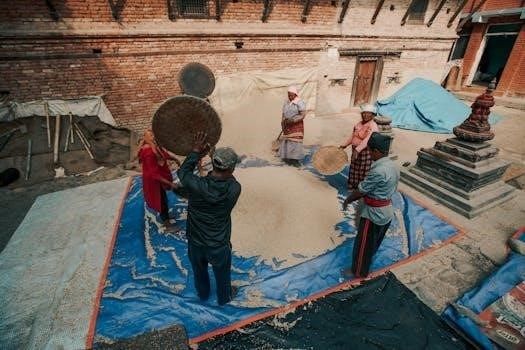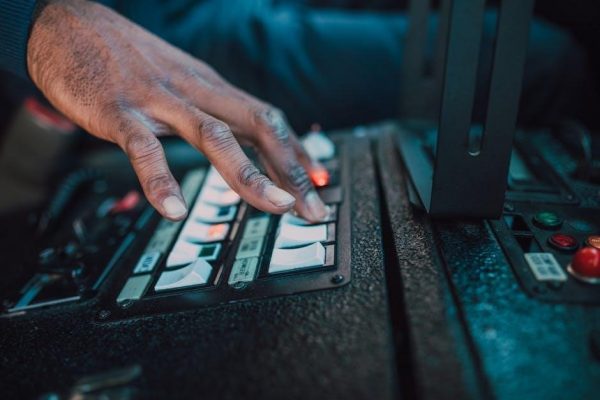This section provides an overview of rice cooker manuals, highlighting their importance for safe and effective operation. These manuals offer essential guidelines, ensuring proper cooking techniques are followed. They help users understand their specific model and its features;
Understanding the Purpose of a Rice Cooker Manual
A rice cooker manual is your essential guide to safely and effectively using your appliance. It provides crucial information about your specific model, including its features and operating instructions. Understanding the purpose of this manual is key to maximizing your rice cooker’s potential. These manuals are designed to help users navigate the various functions, ensuring consistent and high-quality cooking results. They detail the proper techniques for preparing different types of rice, from white to brown, and often include advice on cooking other dishes, like soups or oatmeal. A manual ensures that you use your rice cooker in the way the manufacturer intended. It also prevents damage or misuse. The manual also includes important information about maintenance, troubleshooting, and safety precautions, all of which are very important to the lifespan of the device. By consulting your manual, you can also avoid common mistakes and ensure the longevity of your appliance. The manual is not merely a guide but a vital tool to get the best cooking results.

Safety Precautions
This section outlines crucial safety measures to prevent accidents. Reading the manual is essential before operating the rice cooker. Always follow safety guidelines to ensure safe usage.
General Safety Instructions
Before using your rice cooker, it’s imperative to carefully read all instructions provided in the manual. Always ensure the appliance is placed on a level, dry, and heat-resistant surface, away from flammable or damp surroundings. Do not position the rice cooker near a hot burner or any heat source. Never touch hot surfaces; instead, use knobs or handles. To prevent electrical hazards, avoid overloading circuits with other appliances. The rice cooker may not function correctly if there are too many appliances on one circuit. Make sure the outside of the inner pot is clean and dry before use. Never immerse the base of the rice cooker in water or any other liquid. Unplug the rice cooker when not in use. It is important to keep the rice cooker away from children and pets to prevent accidents. Always use caution to avoid escaping steam.
Specific Safety Warnings Related to Rice Cookers
When operating a rice cooker, it is crucial to adhere to specific safety precautions to prevent accidents or damage. Never use the provided measuring cup for any other purpose than measuring rice. Do not operate the rice cooker if the power cord or plug is damaged. In case of any malfunction, unplug the device and consult the manufacturer. Avoid placing the rice cooker directly underneath cabinets or too close to a wall due to steam release. Do not use the rice cooker without the inner pot in place. Always ensure the lid is securely placed on the rice cooker before starting the cooking process. Never attempt to repair the rice cooker yourself; always seek professional assistance. Do not touch the heating plate after cooking, as it will be hot. Always unplug the rice cooker when cleaning it or not in use.

Basic Operation
This section outlines the fundamental steps for using your rice cooker, including measuring rice and water, adding them to the cooker, and starting the cooking process. Understanding these basics is key.
Measuring Rice and Water
Accurate measurement of rice and water is crucial for achieving perfectly cooked rice. Most rice cookers come with a measuring cup specifically designed for this purpose; using this cup ensures the correct ratio of rice to water. The rice cooking chart within your manual serves as a helpful reference. For example, the manual might state that for every cup of rice, add a specific amount of water, which may vary depending on the type of rice. For softer rice, some manuals recommend soaking the rice for a short period before cooking, which might impact the final water amount. Using broth instead of water can add flavour, but if you’re new to using a rice cooker, sticking with water is recommended for consistent results. Always rinse the rice first to remove excess starch which could affect the texture of the cooked rice. Refer to your specific manual for precise instructions and adjustments based on your rice type and desired consistency. Remember, the outside of the inner pot should always be clean and dry before cooking to ensure the rice cooker operates correctly.
Adding Rice and Water to the Cooker
Once you’ve measured your rice and water, it’s time to add them to the rice cooker. First, ensure the inner pot is clean and dry. Then, place the rinsed rice into the inner pot. After that, carefully pour the measured water or broth over the rice. Some chefs add broth for extra flavor. Make sure the rice is slightly damp from the rinsing process before adding water. The rice cooking chart in your manual will guide you on the appropriate water levels. Ensure that the outside of the inner pot is clean and dry before placing it into the rice cooker. This prevents any issues during the cooking process. The water level should be correct according to the amount of rice used, as specified in your manual. Incorrect ratios can lead to undercooked or overcooked rice. Pay close attention to the instructions and diagrams in your manual for the best results.
Starting the Cooking Process
After adding the rice and water, ensure the inner pot is properly placed inside the rice cooker. Securely place the tempered glass lid onto the rice cooker, making sure it fits snugly. Now, plug the power cord into a 120V AC outlet, if applicable for your model. Once plugged in, press the ‘Cook’ switch to begin the cooking process. The ‘Cook’ indicator light will illuminate, signaling that the rice cooker has started cooking. Your rice cooker may have a countdown timer for white or brown rice. Ensure you have selected the correct cooking setting if your cooker has different modes. Avoid placing the rice cooker under cabinets or too close to a wall as it will emit steam during the process. The cooker will manage the cooking time according to its pre-programmed settings. Refrain from opening the lid during cooking unless instructed to do so in your manual.
Understanding Indicator Lights
Rice cookers typically feature indicator lights that provide crucial information about the cooking process. The most common is the ‘Cook’ light, which illuminates when the cooking cycle begins. This light indicates the appliance is actively heating and cooking the rice. Once the cooking cycle is complete, the rice cooker will often automatically switch to ‘Warm’ mode, and the ‘Warm’ indicator light will then turn on. Some models may have additional lights to indicate different cooking modes, such as ‘Brown Rice’, ‘Quick Cook’, or ‘Steam’. It’s essential to consult your manual to understand the specific meaning of each light on your rice cooker. These lights help you monitor the cooking progress and know when the rice is ready. Ignoring these lights could lead to improperly cooked rice or, in the worst case, cause damage to your cooker. The lights are a simple way for the cooker to communicate its status.

Cooking Process
This section details how rice cookers work, explaining the heating process and the automatic switch to keep warm mode. It also covers best practices to ensure perfectly cooked rice every time.
How the Rice Cooker Cooks Rice
The rice cooker utilizes a simple yet effective method to cook rice. Initially, a heating element located at the base of the cooker heats the inner pot containing the rice and water mixture. The water boils, generating steam, which cooks the rice. As the water is absorbed by the rice and evaporated, the temperature inside the cooker increases. Most rice cookers use a thermostat or sensor to detect this temperature change. Once the temperature reaches a certain point, typically indicating that all the water has been absorbed and the rice is cooked, the device automatically switches from the “Cook” mode to the “Keep Warm” mode. This prevents the rice from burning and keeps it at a suitable serving temperature. Some advanced models may incorporate microprocessors to adjust the cooking time and temperature based on the quantity of rice and type of grains being cooked, ensuring optimal results. Many manuals also include a rice cooking chart for reference.
Switching to Keep Warm Mode
Once the rice is cooked, the rice cooker automatically transitions to the “Keep Warm” mode. This function is crucial for maintaining the rice at an ideal serving temperature without overcooking or burning it. The switch to “Keep Warm” mode is usually triggered by a thermostat or sensor that detects the absence of water and a rise in temperature within the cooker. In this mode, the heating element reduces its power output, providing just enough heat to keep the rice warm. Indicator lights on the cooker will often signify when the unit is in “Keep Warm” mode. It is important to note that the “Keep Warm” function is not designed for extended periods; while the rice will remain warm, the texture might deteriorate over time, and the rice may begin to dry out, this is why most manuals recommend unplugging the device after a few hours. Some manuals also mention that once the cooking cycle has completed, the power switch should be set to “Warm” manually.

Maintenance
Proper maintenance is key to extending your rice cooker’s life. This includes regular cleaning and addressing common issues. Following the manual’s guidance ensures safe and effective operation, avoiding potential problems.
Cleaning the Rice Cooker
Maintaining a clean rice cooker is crucial for both its performance and your safety. Always unplug the cooker and allow it to cool completely before cleaning; The inner pot, often non-stick, should be washed with warm, soapy water using a soft sponge to prevent scratching. Avoid using abrasive cleaners or steel wool. The tempered glass lid, if present, can also be washed in the same manner. Ensure all parts are fully dried before reassembling. Wipe the exterior of the rice cooker with a damp cloth; do not immerse the entire unit in water. Pay attention to the heating plate, removing any stuck-on rice with a soft cloth. Some parts may be dishwasher-safe, but always refer to your manual. Regular cleaning will help prevent odors and maintain your rice cooker in optimal condition. Remember, never place the rice cooker directly under cabinets or too close to a wall.
Troubleshooting Common Issues
If your rice cooker isn’t working correctly, several common issues might be the cause. First, check the power cord and outlet to ensure they are working correctly. If the rice is not cooking, verify that the inner pot is correctly placed inside the cooker. If your rice is burning, it could be due to insufficient water or incorrect rice-to-water ratios. Always refer to the cooking chart provided in your manual. If the unit won’t switch to ‘keep warm’ mode, make sure the cooker isn’t overloaded with rice or other foods. If the indicator lights are not working, check the power supply and consult the manual. Strange smells can indicate a need for cleaning. If the cooker is making unusual noises, it might be a mechanical problem, and you should consult the manufacturer. If these steps fail, you should refer to the user manual for specific guidance or contact customer support.



